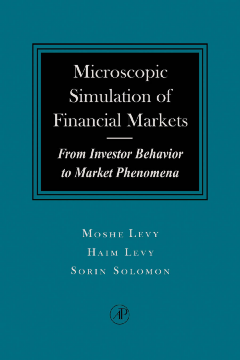
Additional Information
Book Details
Abstract
Microscopic Simulation (MS) uses a computer to represent and keep track of individual ("microscopic") elements in order to investigate complex systems which are analytically intractable. A methodology that was developed to solve physics problems, MS has been used to study the relation between microscopic behavior and macroscopic phenomena in systems ranging from those of atomic particles, to cars, animals, and even humans. In finance, MS can help explain, among other things, the effects of various elements of investor behavior on market dynamics and asset pricing. It is these issues in particular, and the value of an MS approach to finance in general, that are the subjects of this book. The authors not only put their work in perspective by surveying traditional economic analyses of investor behavior, but they also briefly examine the use of MS in fields other than finance.
Most models in economics and finance assume that investors are rational. However, experimental studies reveal systematic deviations from rational behavior. How can we determine the effect of investors' deviations from rational behavior on asset prices and market dynamics? By using Microscopic Simulation, a methodology originally developed by physicists for the investigation of complex systems, the authors are able to relax classical assumptions about investor behavior and to model it as empirically and experimentally observed. This rounded and judicious introduction to the application of MS in finance and economics reveals that many of the empirically-observed "puzzles" in finance can be explained by investors' quasi-rationality.
Researchers use the book because it models heterogeneous investors, a group that has proven difficult to model. Being able to predict how people will invest and setting asset prices accordingly is inherently appealing, and the combination of computing power and statistical mechanics in this book makes such modeling possible. Because many finance researchers have backgrounds in physics, the material here is accessible.
- Emphasizes investor behavior in determining asset prices and market dynamics
- Introduces Microscopic Simulation within a simplified framework
- Offers ways to model deviations from rational decision-making
"Levy, Levy, and Solomon's Microscopic Simulation of Financial Markets points us towards the future of financial economics. If we restrict ourselves to models which can be solved analytically, we will be modeling for our mutual entertainment, not to maximize explanatory or predictive power." --HARRY M. MARKOWITZ, President, Harry Markowitz Co., and Nobel Laureate in Economics
"Many theoretical physicists now try to apply their research techniques to problems in finance; this is a book to help them in such computer simulations. In contrast to earlier "econophysics" books, Levy et al. Emphasize the modeling of individual traders, and they give credit to economists who used such methods already before." --DIETRICH STAUFFER, Physics Department, Cologne University, Cologne, Germany
"This book contains the first fully comprehensive treatment of Microscopic Simulation in finance. The authors make a compelling case that this technique, originally used in physics to solve otherwise intractable problems, is destined to become a standard tool in finance. It is particularly well-suited for highly complex financial problems in behavioral finance where standard methods are inadequate." --RICHARD ROLL, Allstate Professor of Insurance and Finance at the Anderson School of Business, UCLA
